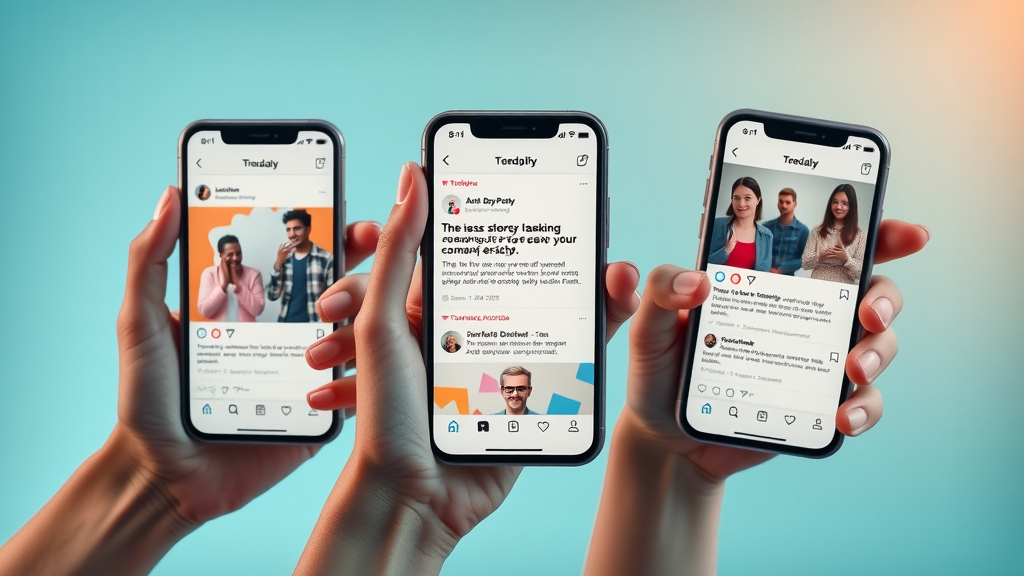Did you know: Brands with a social impact narrative are 65% more likely to gain lasting customer loyalty. Brand storytelling für social impact is no longer just a buzzword—it's a powerful tool for touching real hearts and building a strong brand identity that goes beyond numbers. In this comprehensive guide, you’ll learn what makes brand narratives so compelling, see inspiring case studies, and get actionable strategies to start crafting your own story for genuine social change. Dive in and discover how the right story elevates your brand and inspires action.
Why Brand Storytelling für Social Impact Moves More Than Just Numbers
In today’s world, data alone is not enough to move people—you must connect emotionally if you want your brand story to resonate and inspire positive change. Brand storytelling für social impact taps into our deepest values, helping brands stand out by aligning their mission with causes that matter. This combination drives real impact and puts your impact brand ahead of the curve. Customers today are looking for more than a product; they’re seeking a narrative that mirrors their own beliefs and aspirations.
Take, for example, a social good business that shares the real-life journeys of its founders and community. Their brand stories don’t just sell products—they share what drives their mission, why it matters, and what positive change they help spark. This builds trust and turns customers into brand advocates. The modern brand thrives by engaging hearts, not just pocketbooks, and your story is the bridge to meaningful, lasting impact.

- A recent study reveals: Brands with a social impact narrative are 65% more likely to gain lasting customer loyalty. Learn how your brand can leverage storytelling to become an impact brand that resonates.
Unlocking the Power of Brand Storytelling für Social Impact: What You Need to Know
- Understand what makes brand storytelling für social impact uniquely compelling.
- See practical examples of social impact brands using engaging stories to spark change.

- Learn actionable steps to craft your own strong brand story for social media.
- Recognize the emotional triggers and strategic insights behind building a modern brand with real social change.
- Discover which social media channels are most effective for your impact brand’s message.
What you’ll learn: Why social impact matters for brands, what makes effective brand storytelling, and how to leverage modern tools to connect with your customer base through social good initiatives.
Defining Brand Storytelling für Social Impact: Building a Strong Brand in a Modern World
What Is a Brand Story? The Foundation of Every Social Impact Brand
At its core, a brand story is the narrative that sets your organization apart. For a social impact brand , this narrative goes beyond product features—it details the journey, values, and vision that fuel your social initiatives. Every effective brand starts with a compelling story that articulates the conflict or challenge your brand seeks to solve and the change you hope to bring about. When crafted authentically, this narrative becomes a magnetic force, attracting supporters, customers, and partners.
The brand story is the foundation upon which impact organizations build trust and create emotional connection. It defines who you are, why you exist, and how you’re driving positive change. For any impact organization, storytelling is the linchpin that unites team members, inspires donors, and rallies communities around your cause. Whether it’s a story of a single person’s journey or the sweeping vision of a collective movement, it’s this authenticity that anchors your success.

How Social Impact and Brand Storytelling Intersect to Drive Change
When a brand story is wedded to a clear social initiative , storytelling becomes much more than a marketing strategy; it drives real change. Social impact stories clarify the reason your brand exists and demonstrate the tangible outcomes of your work. By putting faces and names to a cause, you humanize complex issues, empowering your customer base to feel part of the solution. This is a defining factor for the modern brand looking to make real impact in a crowded marketplace.
The intersection of social impact and brand storytelling helps organizations turn abstract missions into relatable, actionable narratives. It also creates a powerful loop: as you share authentic stories, you inspire action, and these success stories in turn fuel your next campaigns. “The most powerful tool in branding isn’t advertising — it’s an authentic and relatable story.”
Why Modern Brands Need a Social Impact Narrative
In our hyperconnected world, a social impact narrative has shifted from being a bonus to being an expectation. Brands that champion social good—whether environmental sustainability, human rights, or community development—stand out as leaders in a landscape crowded with options. The elements of effective brand storytelling für social impact —relatability, clarity, and consistency—are critical to building a strong brand that stands the test of time.
- Emotional engagement is a secret ingredient: when audiences feel invested, they’re more likely to stay loyal and advocate for your cause.
- Modern brands need to weave their social impact and ethics into every facet of their messaging, not only because it’s the right thing to do but because it drives better business outcomes.
Driving Real Connection: Why Brand Storytelling für Social Impact Resonates
Humanizing Your Social Impact Brand with Authentic Stories
Audiences today crave authenticity. Brand storytelling für social impact brings a human face to your social initiatives, letting your customer base connect with real struggles and triumphs. When you share honest, vulnerable stories—from founders overcoming adversity to communities benefiting from your work—you empower people to relate, care, and get involved. This emotional connection is the bedrock of any impact brand .
Real impact begins with a true story. When audiences recognize themselves in your journey or see how your social impact organization is alleviating real-world problems, they’re moved to support, share, and champion your brand. More than just content, it’s about building authentic stories that create long-lasting, emotional connections.
How Social Media Multiplies the Effect of Your Brand Storytelling
With billions of users, social media is a megaphone for today’s impact brands. By pairing the right content strategy with emotionally charged storytelling, brands can ignite viral movements, unite communities, and deeply enhance brand awareness. The interactive nature of platforms like Instagram, TikTok, and LinkedIn lets you tell brand stories in fresh, innovative ways—through photos, videos, lives, and collaborative posts that generate buzz and real impact.

- Craft impactful narratives for Instagram, TikTok, and LinkedIn—each platform demands unique storytelling techniques for maximum reach.
- Integrate your brand storytelling into your content strategy for greater visibility, engagement, and advocacy.
Brand Stories that Inspire: Best-in-Class Social Impact Brand Examples
Case Studies: Modern Brands Using Storytelling for Social Change
Brand storytelling für social impact is brought to life when we look at real-world case studies and success stories. Impact brands like Warby Parker, TOMS, and Patagonia shape brand identity by sharing the genuine challenges they faced and how their products give back to the community. These stories drive emotional engagement, build strong brand loyalty, and demonstrate the power of narrative as a marketing strategy.
In particular, TOMS leverages its One for One campaign not just to sell shoes but to highlight the story of giving back—showing real impact through detailed outcomes and personal stories. Meanwhile, Patagonia’s environmental campaigns rely on authentic storytelling to spark community action and rally support. These modern brands prove that storytelling does more than boost numbers; it forges a movement.
| Brand | Impact Objective | Key Story Element | Social Media Channel | Outcome |
|---|---|---|---|---|
| TOMS | Providing shoes for those in need | Personal beneficiary stories | Instagram, YouTube | Increased brand loyalty and advocacy |
| Warby Parker | Vision care access | Customer and recipient narratives | Instagram, Twitter, LinkedIn | Brand awareness and positive change |
| Patagonia | Environmental protection | Founder’s activism journey | Instagram, Website Blogs | Mobilized customer base for climate action |
"Every great social impact brand started with a single, genuine story." – Social Impact Strategist
The Anatomy of Effective Brand Storytelling für Social Impact
Essential Elements of a Strong Brand Story

Every effective brand story, whether for an impact brand or commercial organization, incorporates specific elements to ensure longevity and resonance:
- Relatability: Make your audience the hero. Build stories where the customer, beneficiary, or community is at the heart of your narrative, driving emotional connection and deeper engagement.
- Clarity: Define your social impact goal clearly. Audiences want to know what you stand for, how you are making social good happen, and what they can do to participate.
- Consistency: Across all channels, maintain the same brand voice and visual identity for a strong, cohesive presence. Consistency builds trust and brand awareness over time.
- Authenticity: Honest stories outperform polished, generic content. Audiences know when a narrative is manufactured; share both successes and failures to cultivate genuine belief in your mission.
Combining these essentials creates a powerful tool for impact organizations to build strong, lasting relationships and become a truly modern brand that champions social change.
Crafting Your Brand Storytelling für Social Impact: A Step-by-Step Guide
- Define your mission and core values as a social impact brand. Lay the foundation by clearly articulating what your organization stands for and the change you wish to create.
- Identify your audience’s biggest emotional triggers. Research what truly matters to your customer base to guide compelling story themes and topics.
- Map out your brand story: From challenge to change. Frame your journey, highlight obstacles, and celebrate the transformation catalyzed by your efforts.
- Choose the right social media channels for your brand storytelling. Each platform has unique strengths—Instagram for visual branding, TikTok for viral video, LinkedIn for professional impact brand engagement.
- Measure the results, optimize, and adapt your brand content strategy. Use both quantitative and qualitative data to refine narratives and maximize reach.

Integrating Brand Storytelling für Social Impact into Your Social Media Strategy
Selecting the Best Social Media Platform for Your Brand Story
The choice of social media platform can make or break your brand story’s reach. Instagram’s fast-paced visual style is excellent for eye-catching impact stories and audience engagement; TikTok’s short-form videos let you show the energy and authenticity behind your mission; while LinkedIn’s professional network is ideal for sharing in-depth narratives, thought leadership, and expanding your impact organization’s profile with partners and investors.
Consider your target audience—their age, interests, and preferred content style. Modern brands excel by tailoring their presence and content strategy to the platform that best magnifies their message. Savvy use of channels ensures your story not only gets seen but also inspires action.
How to Adapt Brand Stories Across Different Channels
Adapting your brand story for different platforms means much more than resizing images—it’s about customizing your message and format. On Instagram, leverage visual storytelling with infographics and behind-the-scenes snapshots. TikTok or YouTube are made for energetic, authentic video content that captures hearts fast and spreads quickly. For LinkedIn, focus on thought leadership, data-backed results, and moving testimonials from those impacted by your work.

- Visual storytelling on Instagram
- Video content for TikTok and YouTube
- Thought leadership and community on LinkedIn
- Leveraging social impact hashtags for greater reach
Remember, a strong brand story shines brightest when told with relevance for each medium, driving better user engagement and enhanced brand awareness.
Measuring Success: KPIs for Brand Storytelling für Social Impact
Quantitative & Qualitative Metrics for Social Impact Brand Stories

To know if your story is truly making an impact, measure both numbers (quantitative) and narratives (qualitative). Track metrics like engagement rates, shares, comments, click-throughs, and donation or signup rates. More importantly, pay attention to stories shared by your community, testimonials, and the quality of your interactions. This is how impact organizations know they're building real connection, not just traffic.
Listen to your audience—what stories are they sharing back? Are your brand stories inspiring conversations offline and in the communities you serve? The combination of hard data and real-world feedback is a hallmark of the most effective brand storytelling für social impact strategies.
How to Use Data to Refine Your Social Impact Brand Narrative
Numbers tell part of the story; real impact comes from interpreting that data and adapting your content strategy . Analyze which types of posts perform best, when your audience is most active, and what sparks the most meaningful engagement. Use these insights to sharpen your messaging, double down on successful campaigns, and pivot where needed. This data loop keeps your impact brand agile and responsive as social context shifts.
Surveys and interviews also uncover qualitative insights, revealing what's resonating on a deeper level and where your brand story may need more clarity or authenticity. Armed with this knowledge, you can revise and elevate your narrative to foster deeper loyalty and reignite your community’s passion for positive change.
- Watch how a modern brand leverages storytelling for sustainable results.
- Explore how narrative-driven campaigns deliver on both heart and business objectives.
People Also Ask: What is an example of storytelling for social change?
- Nike’s ‘Dream Crazy’ campaign embraced brand storytelling to support social impact by championing athletes who break barriers and drive societal progress.

People Also Ask: How does storytelling impact society?
- Brand storytelling für social impact shapes public perception, influences behaviors, and fosters empathy, driving collective action toward meaningful change.
People Also Ask: How can storytelling create social change?
- Effective brand stories humanize issues, mobilize communities, and empower audiences to support or participate in social impact campaigns.
People Also Ask: Which social media platform is best for brand storytelling?
- Instagram and TikTok excel for visual impact, while LinkedIn is prime for in-depth social impact brand narratives and professional engagement.

Expert Answers: Frequently Asked Questions on Brand Storytelling für Social Impact
-
How do you balance authenticity with strategic messaging?
Always start with real stories and genuine voices, but align your message with your goals. Authenticity isn’t about oversharing; it’s about consistency and transparency around your values and impact. -
Can small brands leverage brand storytelling for social impact as effectively as big brands?
Absolutely. Smaller organizations often have the advantage of more personal, relatable stories. With the right content strategy, they can create deep emotional connections and even outshine bigger players. -
Where do you find brand story inspiration for social impact narratives?
Talk to your community, team members, beneficiaries, and supporters. The best stories come from lived experiences and real transformations. -
What is the most effective format for a brand story on social media?
Short videos, compelling visuals, and authentic behind-the-scenes posts work especially well across platforms. Experiment and see what resonates most with your specific audience.
Key Principles for Lasting Impact Through Brand Storytelling für Social Impact
- Keep your social impact brand’s values at the forefront of every story.
- Combine emotional truth with actionable goals.
- Revisit and refresh stories as your brand and social context evolve.

Ending: Elevate Your Social Impact with Purposeful Brand Storytelling
- Start shaping your impact brand legacy by embedding powerful brand storytelling into every campaign.
- Share your most compelling story on social media today—your audience, and the world, are waiting.
Take Action: Use your brand story to move hearts, rally support, and make a lasting impact—start telling your social impact narrative today!
Incorporating brand storytelling into your social impact initiatives can significantly enhance your brand’s connection with consumers. For instance, Patagonia’s commitment to environmental sustainability is exemplified through their “Don’t Buy This Jacket” campaign, which encourages consumers to consider the environmental impact of their purchases. ( socialtargeter.com ) Similarly, TOMS Shoes’ “One for One” model, where each purchase leads to a donation to someone in need, effectively communicates their dedication to social responsibility. ( socialtargeter.com ) By studying these examples, you can learn how to craft authentic narratives that resonate with your audience and drive meaningful engagement.
 Add Row
Add Row  Add
Add 




Write A Comment